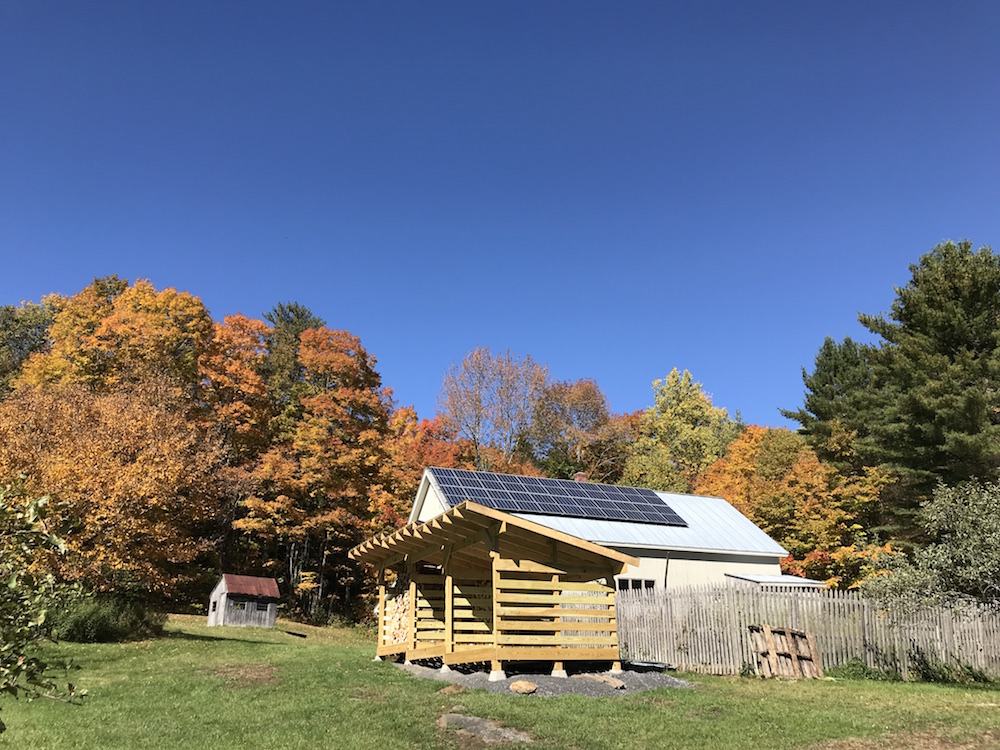
This is the post you’ve all been waiting for. This is the answer to your prayers and the deliverer of miracles. That’s right, I’m finally writing about our solar panels. I know you’re thrilled. Actually, I think ten of you are, in fact, thrilled and the rest of you will read along just to see hot panel pics. I know I would.
As everyone in the world knows (or at least, everyone who follows along with Frugalwoods on Instagram), we decided to have solar panels installed on our barn roof last November. I admit this date to you and I admit it took me a year to write this post. I’m an embarrassment to my profession. I mean seriously… I could list my excuses, but I won’t. Ok actually I will: I had a baby, I have a toddler, we run a homestead (“run” is too intense a word, “limp along” might be more appropriate), and I published my first book! Alright enough with the excuses, you’re thinking, give us the dirt on those panels!!!!! And include pictures!!
Upon further reflection, I MEANT to wait a year to write about our solar panels because now I have a year’s worth of data to share with you! See? I am strategic in my procrastination. In truth, it is nice to have a full year of records to share since our seasons vary so wildly here in Vermont.
A disclaimer that Mr. Frugalwoods was instrumental in providing a lot of the data for this post (last May… ), and so to him, we owe a debt of gratitude.
Solar Panel Basics: Array Size
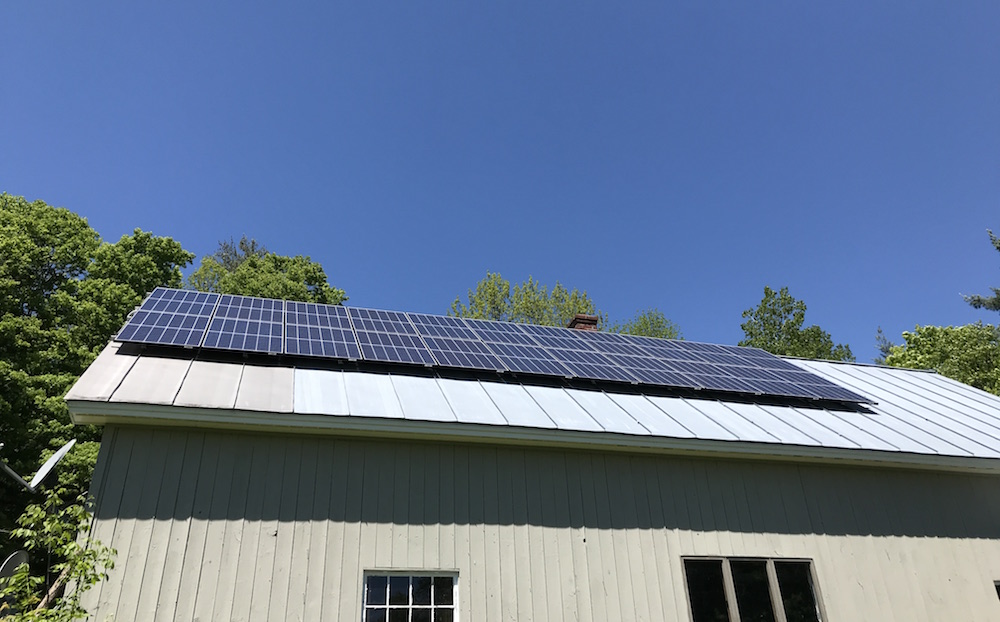
We had 22 panels installed on the metal roof of our barn in November 2017. These panels generate 280 watts each, which means we have a total of 6,160 installed watts (this is also known as the nameplate production). Our installer predicted that the annual yield for our array would be 5,667 Kilowatt-hours (kWh). Lo and behold, this past year we’ve produced 5,690 kWh, which is fantastically close to our installer’s estimate!
Our barn roof ended up being the best location to install the panels because:
- It faces southeast and gets mostly full sun (there are no trees or structures shading it)
- It is a simple, pitched, standing seam metal roof (unlike the roof of our house, which has skylights, dormers, and a ton of angles)
- There is plenty of room leftover for us to–possibly–install more panels in the future, should we choose to expand our solar capacity.
We considered a ground array, but the barn is so well sited and the roof so unused that it seemed ideal.
Solar Panel Basics: Cost
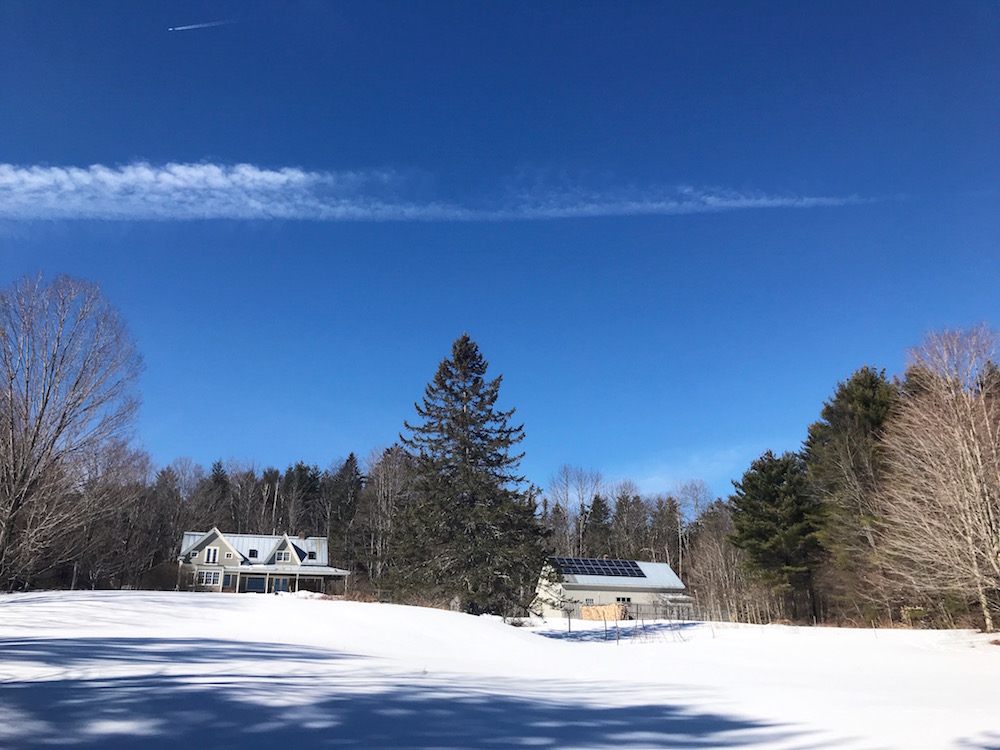
We paid cash in full for our solar panels, as opposed to financing them with an interest rate. Here’s what we paid:
$18,603 was the total price, including the panels and their installation
– $5,580.90 in federal tax credit (30%, this is what was available in 2018)
= $13,022.10 was net of tax credit (our actual outlay after receiving the federal tax credit)
This breaks down to:
- $2.11 per nameplate watt
- $2.30 per annual kWh
Mr. Frugalwoods modified a spreadsheet he found online (unfortunately, he can’t find the source now… a casualty of me waiting a year to write this up… ) to calculate the long term return on investment (ROI) of going solar. He took into account that:
- Electric rates rise over time
- Solar panels can decrease their output
- The possibility of replacing the inverters every 10 years
Projecting these out for the future, he came up with the following Internal Rate of Return (IRR) numbers:
-4.41% 10 year IRR
8.41% 25 year IRR
This IRR illustrates that the payback on solar is good over the long term, but not so great in the short term. We plan to stay in this house for a long time, and thus hope to fully realize that 25 year IRR. (IRR, by the way, is a method of evaluating an investment over a period of time).
Personally, we view solar as a risk-reducing investment, not unlike longterm bonds (which typically have a lower rate of return, but less volatility, than our more aggressive index funds, for example). The greatest risk with solar is the long time horizon for the return and the potential for regulatory changes.
In Vermont, there’s an established history of grandfathering in solar rate plans, so we’re hopeful that our regulatory risk is small. Again, it’s a longterm proposition and these are all projections that could be proven wrong in the future.
DIY (per usual) Would Be Cheaper
The financial returns would be more of a slam dunk if you designed and installed a solar system yourself, which we did not do (and yes, I realize I just said ‘solar system’). More than half the cost of our system was in labor for the installation. However, given the changing regulatory frameworks both nationally and locally, we thought it prudent for our situation to go ahead and pay a premium to have it done professionally. Plus, neither Mr. FW nor I is a fan of heights or working on roofs, which is kind of necessary in order to instal panels on a roof. And yes, we considered getting a ground array to negate this roof situation, but in the end, the roof of our barn was the optimal site for the array.
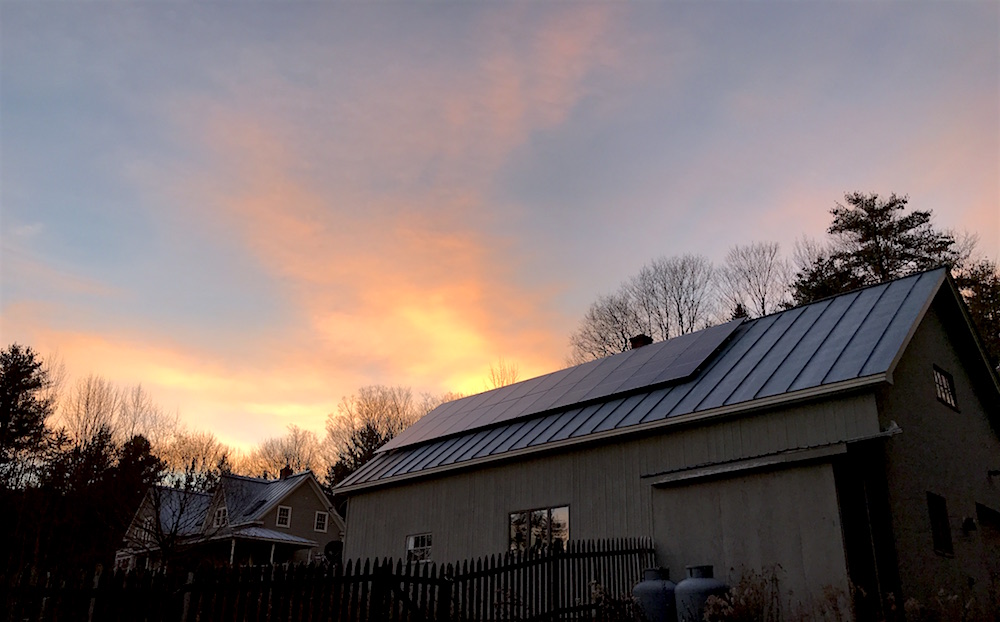
Though I’m usually a proponent of doing projects ourselves, I also think it’s important to know one’s limits in terms of expertise and physical safety. Installing solar was pretty far outside both of these limits for us.
Our Electrical Utility + Our Solar Array
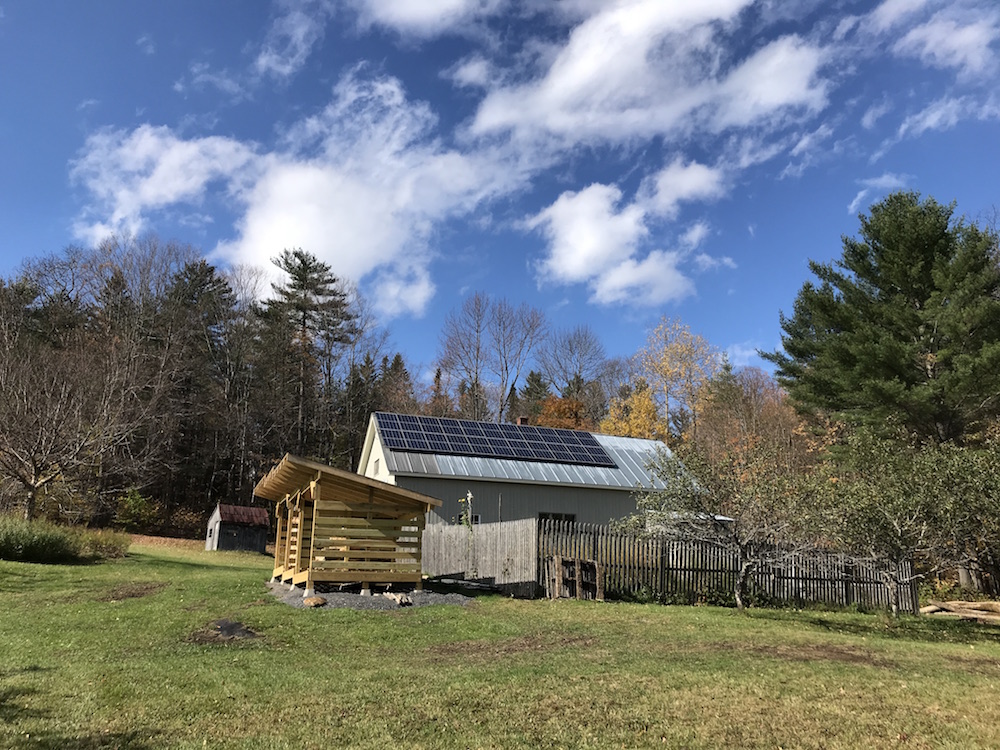
We Are Net Metered
What’s that? It’s when you toss a butterfly net over a parking meter. Very avant-garde, you understand.
Net metering in THIS context means “a system in which solar panels or other renewable energy generators are connected to a public-utility power grid and surplus power is transferred onto the grid, allowing customers to offset the cost of power drawn from the utility.”
Since we are net metered, we are still on the power grid and are still electric co-op customers. We made this decision for several reasons:
- We didn’t want to have to own batteries to power us when the sun isn’t shining. Batteries are expensive, tend to need a lot of maintence, and are more cumbersome than simply using grid power (meaning the power from the electric utility company).
- Vermont has decent net metering rules: we get paid $0.26 / kWh in generation credit for each kWh we sell to our electric co-op, while we only pay $0.11 / kWh for the first 200 kWh we use each month and $0.23 / kWh after that (net of any solar production that month).
Wait, Doesn’t It Snow A Lot In Vermont?

Through net metering, we’re able to bank our summer sunshine for use in the wintertime, which keeps our electric bill low year-round, even when the sun isn’t shining.
True to our expectations, we produced a dismal amount of solar during the winter months and an astronomical amount during the summer months. Since we’re able to bank that summer sun, it has–thus far–evened out. See the above graph to illustrate the seasonal nature of our solar production.
We aren’t paid cash by our electric co-op for our excess solar, but we offset our usage during non-sunny times. These generation credits expire 12 months after generation, so for example, excess solar banked in June 2018 will expire if not used by June 2019. In light of this, there’s no incentive for us to produce more solar than we use. Furthermore, our co-op doesn’t allow us to offset the fixed charges on our electric bill, so our bill isn’t $0, rather it’s around $17 per month. See a recent electric bill below:
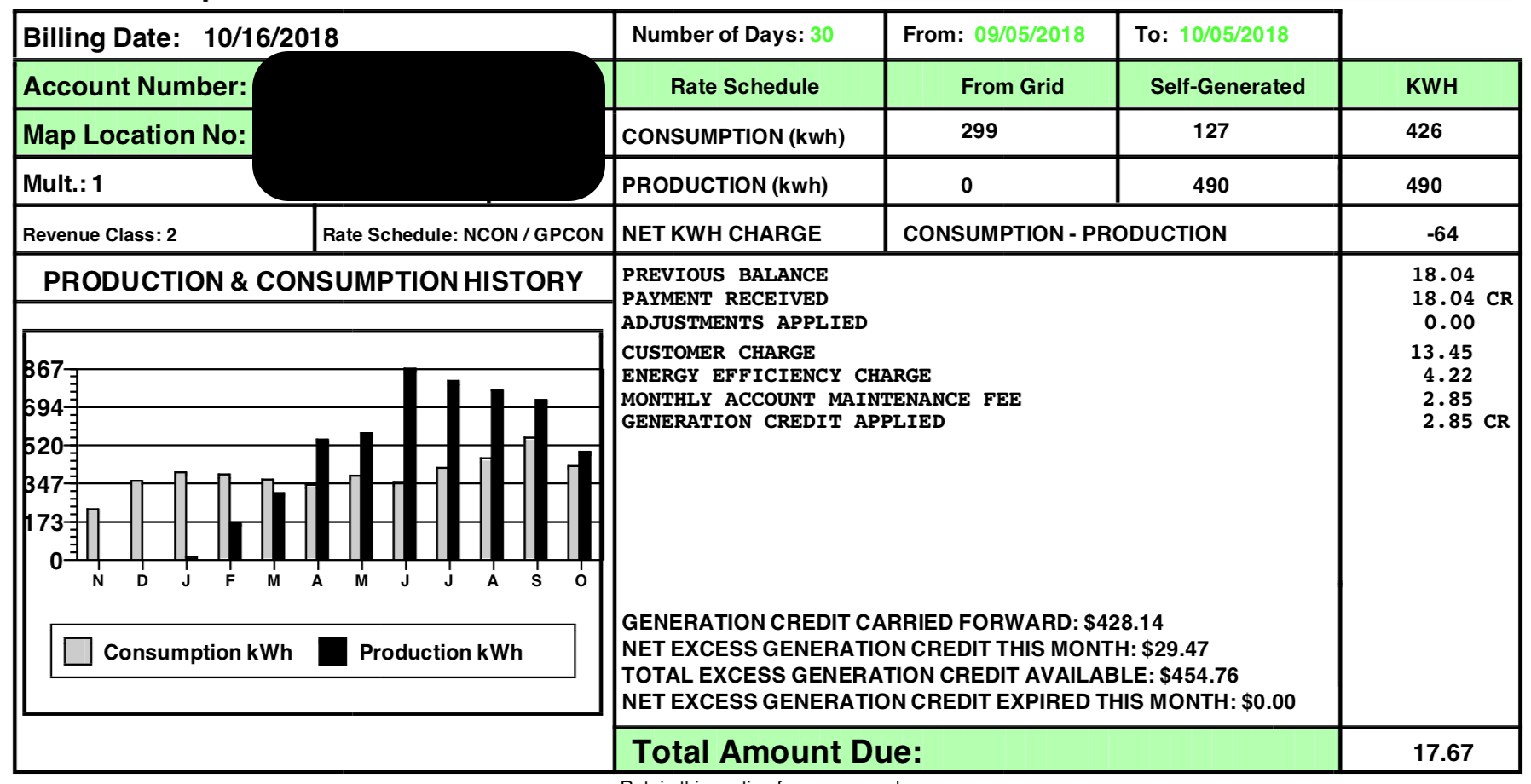
Frugalwoods Family Electricity Usage
We sized our solar array to meet our annual usage, including the conversion of our hot water heating from propane to a heat pump hot water system. Propane is super expensive, and solar energy is cheap (plus better for the environment) so this made the economics nice.
Our Heat Pump Hybrid Electric Water Heater
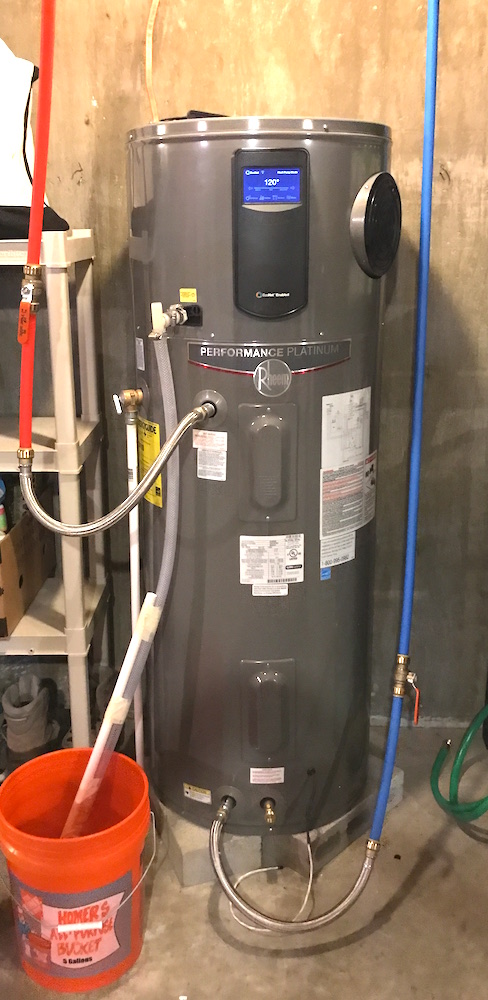
In July 2018, we converted to a heat pump hybrid electric water heater (HPHW) that eliminates our need for propane (for hot water) and allows us to leverage our solar power. It’s 3.5 times more efficient than a standard electric water heater and, due to its energy-efficiency, it qualified for two massive rebates:
- $500 from Efficiency Vermont
- $250 from our electric company (Washington Electric)
The water heater was $1,299 from Home Depot and these two rebates brought our cost down to a mere $549. Mr. Frugalwoods installed the water heater himself, which saved us several hundred (a thousand?) dollars on the cost of installation. This was no easy feat since we were going from propane to electric and so he had to install a new 220 circuit. He also did all the plumbing for it using PEX and added ball valve shut-offs. The water heater technically requires a condensate drain, but we’re just using a 5 gallon bucket right now since it doesn’t actually drain very much water. If it turns out to be an issue, we’ll put in a condensate pump.
Here’s a breakdown of our previous propane costs:
- Annual propane usage for hot water (estimate): 200 gallons
- Price per gallon of propane: $2.66
- Annual propane cost: $532
We estimated how much electricity we thought the HPHW would add to our annual electricity usage, based on the amount of propane we used in a year. We were assuming we’d end up using about 100 kWh per month, but it turns out we’re averaging more like 60 kWh per month, which is great!
We’ll have to see if it remains as efficient through the winter, however, with a colder basement. Without solar, those 60 kWh a month of water heating electricity would almost certainly be at our marginal cost of $0.23 / kWh, which comes to $13.80 a month or $165.60 annually, which is still a win compared to propane! But it’s an even better deal since that electricity is coming from our solar. Plus, it’s really nice to reduce our dependence on imported fossil fuels, whose prices have historically been very volatile.
The HPHW project is turning out to be a win of epic proportions. Even if we were paying the highest tier price for electricity ($0.23 / kWh) the cost of running it is only (60 * 0.23 = 13.80 * 12 ) $165.60 annually vs. $532 for propane. And propane is currently quite cheap by historical standards. Thus, we’re saving $366.40 a year, which means our payback period will be just 1.5 years for our new water heater!!
Other Uses Of Electricity
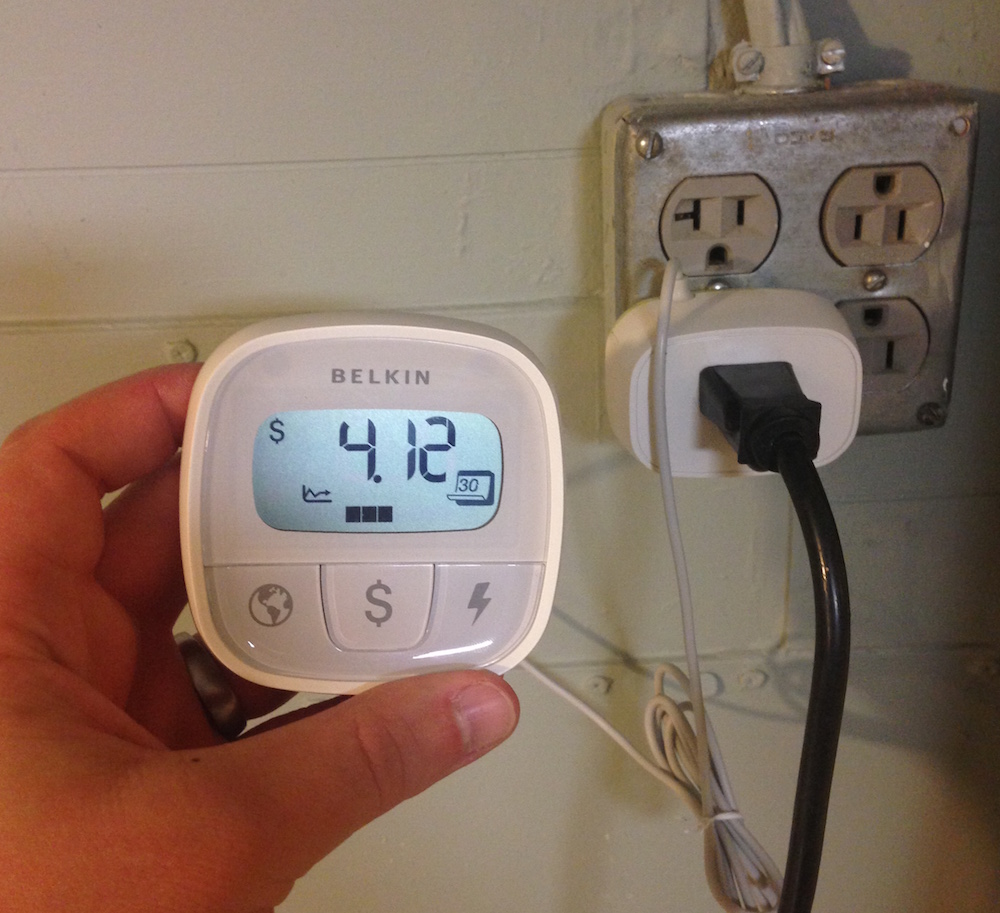
As you can see, our primary electricity usage is for our hot water heater. But of course we also use electricity in our:
- Lights: we have high-efficiency LED lightbulbs, which utilize a modicum of energy.
- Well pump: for pumping water from our well. It doesn’t use all that much electricity but the bummer is that when the power is out, we don’t have water either.
- Pump for our oil-fired baseboard heating system: we don’t use our oil heat very often, but if we did it might be a significant drain.
- Air conditioning window units: we don’t have central air, but we did use several window units during our unusually hot and humid summer. For many people, AC is their #1 energy hog.
- Appliances: these have the potential to be mega energy sucks. I’ve talked with folks who are baffled by their energy bill because they have LED lightbulbs and are cognizant of how much electricity they’re using and yet, they have enormous bills. Often, the culprits are old, inefficient appliances. Refrigerators, freezers, washers, dryers, and their ilk. In our previous home, we discovered that the ancient fridge/freezer in our basement (which was there when we moved in) was a massive energy hog and that we would save money by purchasing a new, Energy Star certified efficient chest freezer. More on that here: Why Buying A Chest Freezer Is Saving Us Serious Money. For this reason, I often advise against buying appliances used. Even though a used appliance will be cheaper than a new one at the outset, your longterm energy costs are likely to be much greater.
If you think you might have energy hog appliances (or just can’t figure out why you’re using so much electricity), I recommend you get (or borrow) an energy use monitor, which measures the amount of electricity a given device uses over time (affiliate link). The beauty of this gadget is that it averages energy usage over time and thus isn’t merely measuring what the appliance utilizes in a given moment.
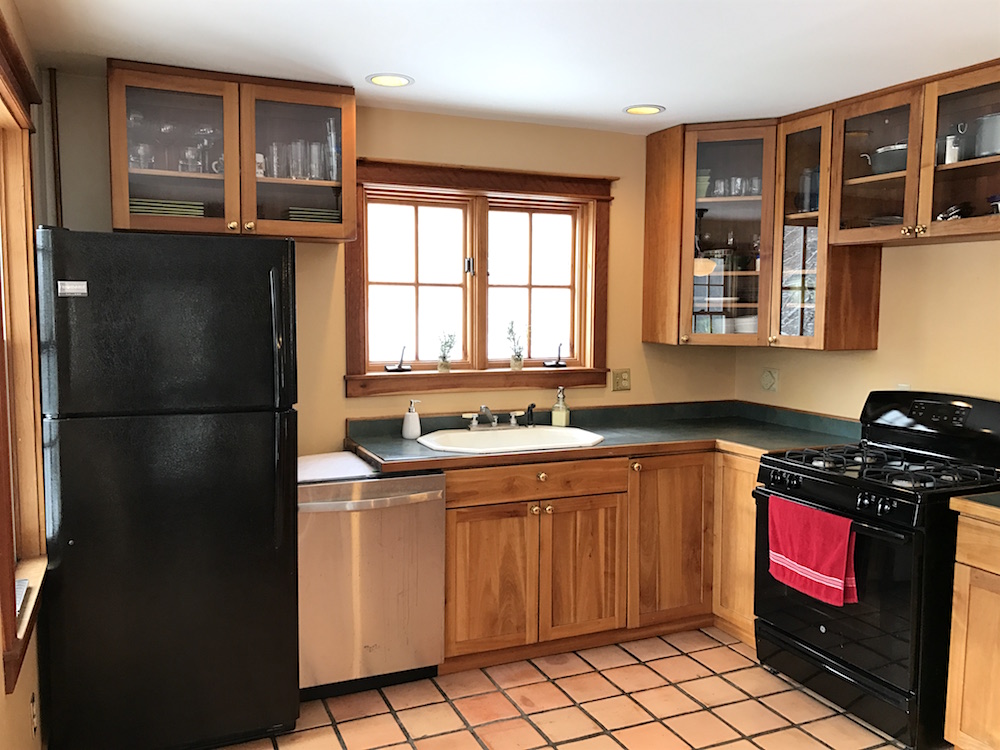
This averaging capability is crucial for things like refrigerators since they cycle through higher and lower periods of energy consumption. The monitor translates this usage into cold, hard cash–you type in how much you pay per kilowatt hour (printed on your handy dandy electricity bill) and it displays how many dollars per month, kilowatt hours, and pounds of C02 the device in question consumes/emits. We have this monitor because we like the interface, which has an external display–much easier to employ with an appliance such as a fridge that’s difficult to snake behind in order to read an outlet-mounted monitor (affiliate link).
Currently, our appliances are fairly efficient. We have a high-efficiency washer and dryer (and try to hang dry a fair number of clothes to cut down on dryer usage). We have an elderly flat-panel TV that doesn’t use too much electricity (it’s not a smart TV, which means it doesn’t use electricity when it’s turned off), the fridge/freezer in our kitchen is OK, and we still have that Energy Star certified chest freezer in our basement. We plan to redo our kitchen at some point and would like to get a more efficient fridge/freezer at that time.
We’re toying with the idea of possibly, perhaps, one day getting an electric car, which would run off of our solar power. That purchasing decision is still many, many years away since we’re very happy right now with our 2010 Toyota Prius and 2010 Toyota Tundra. But, that possible future electric vehicle was one of the reasons we positioned our solar array as we did. There’s enough space on the barn roof for us to fully double the number of panels we have if we so choose in the future.
How We Chose Our Solar Company

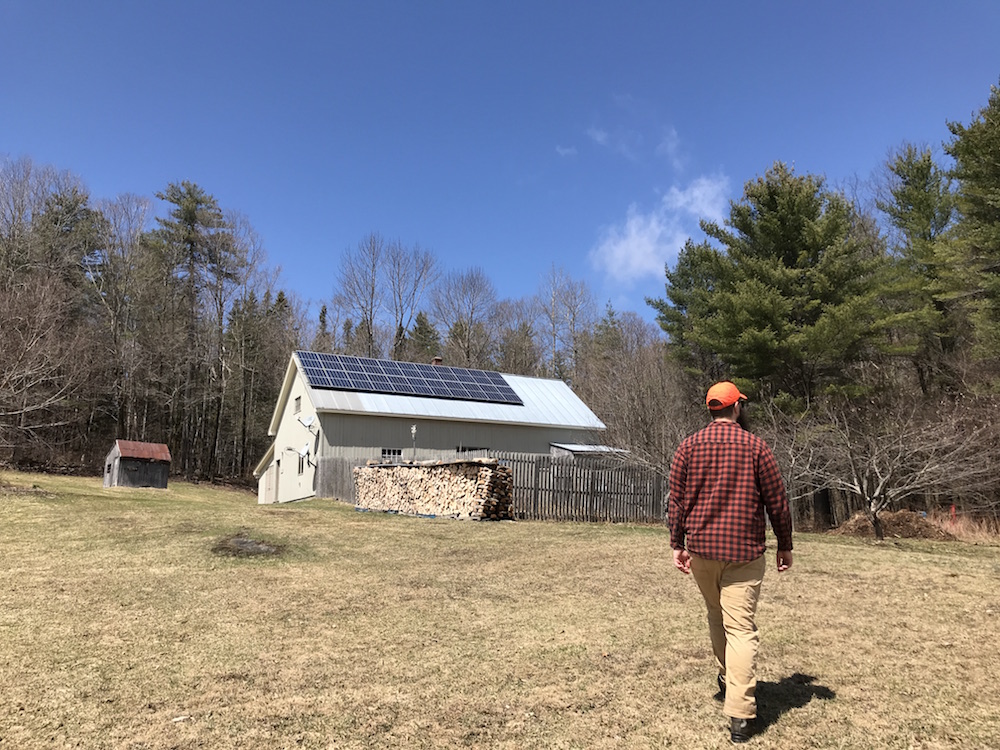
Another factor in our choice of Catamount Solar is our desire to support local Vermont businesses who provide good jobs for Vermonters (we’re a state that needs jobs and employers!). Catamount Solar–in addition to having a stellar name–is a Vermont-based member-owned worker’s cooperative, a business model that we respect.
Funny story, when the rep from Catamount Solar came to our house, he gave us a strange look and said, “Are you the Frugalwoods by any chance?” Turns out, his wife is a reader and had tipped him off that it just might be us. We got a kick out of that and hey, how could we turn down a Frugalwoods reader?
More Than Just Money: The Environmental Angle
Another reason for our decision to get solar is our desire to make lifestyle choices that benefit the environment. By capitalizing on clean solar energy, we’re able to decrease our dependence on fossil fuels. In particular, we’ve been able to dramatically reduce our propane consumption, which is a financial and environmental win. Solar is a wonderful element of our desire to increase our homestead’s sustainability and decrease our overall carbon footprint.
A Year Of Solar In Review
Well, almost a year. Our panels weren’t connected to the grid and up and running until mid-November 2017, so we’re a few weeks shy of a year. But I could not put off writing this post any longer. Thus, the chart below includes an estimation of how much we’ll generate and use for the last few days of our current billing cycle.
| Month Ending | Solar Generation | Energy Consumption | With Annualized Water Heating |
| 11/4/2017 | 0 | 229 | 289 |
| 12/4/2017 | 0 | 357 | 417 |
| 1/4/2018 | 13 | 397 | 457 |
| 2/5/2018 | 167 | 387 | 447 |
| 3/6/2018 | 302 | 363 | 423 |
| 4/4/2018 | 544 | 340 | 400 |
| 5/5/2018 | 574 | 382 | 442 |
| 6/5/2018 | 867 | 348 | 408 |
| 7/5/2018 | 811 | 418 | 418 |
| 8/5/2018 | 768 | 461 | 461 |
| 9/5/2018 | 725 | 554 | 554 |
| 10/5/2018 | 490 | 426 | 426 |
| 11/4/2018 | 302 | 401 | 401 |
| Total: | 5,563 | 5,063 | 5,543 |
What this chart shows is that in the last 12 months, we’ve generated about 500 kWh more than we’ve used. However, we didn’t install the heat pump hybrid electric water heater until July, so we’re missing six months worth of that data for an actual break even. If you add that in (we use about 60 kWh / month for the heat pump hybrid electric water heater) for the months before the install, we’d be ending the year within 100 kWh of our production, which is exactly where we want to be. We’ll keep an eye on our generation vs. consumption and it’ll be interesting to see how our banked credits are utilized throughout the year. I’ll let you know how it goes!


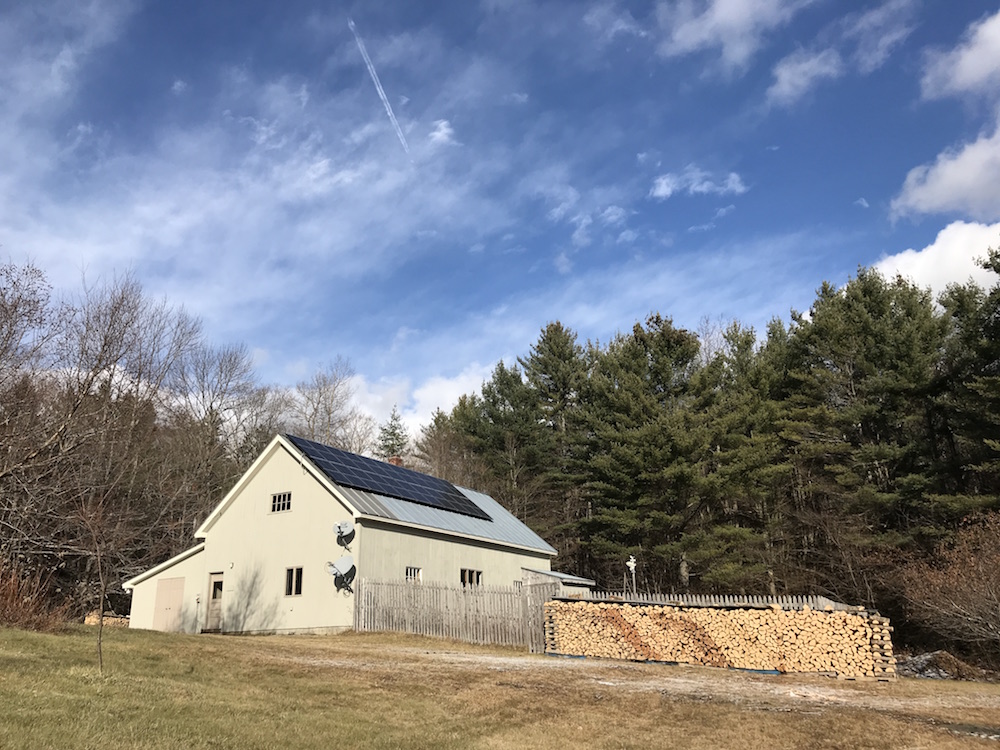

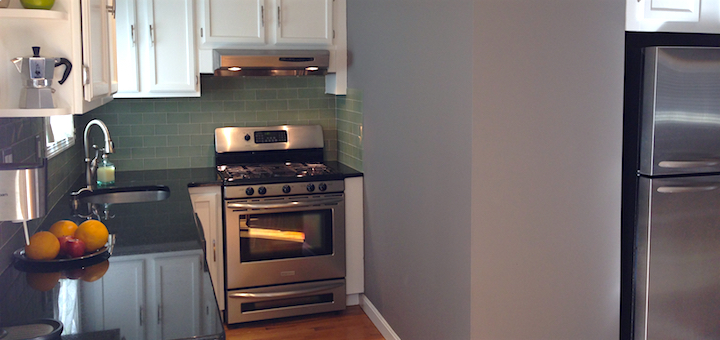

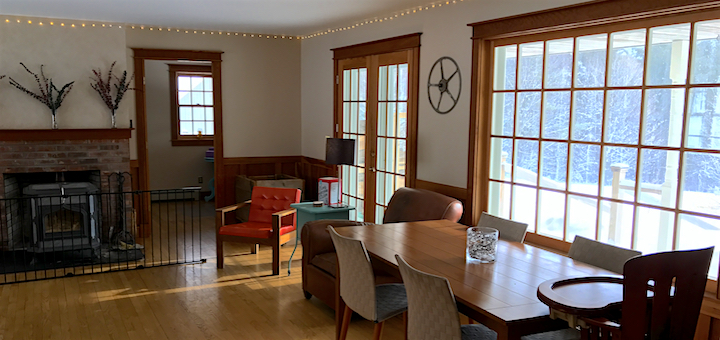

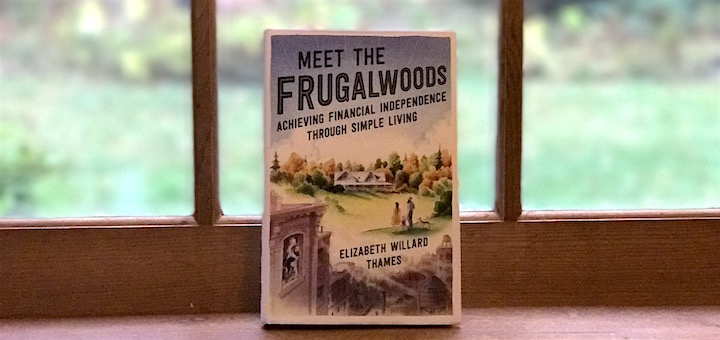
Good stuff! I really want solar for my house but my roof is angled the wrong way for optimization and there a tree in my neighbors yard that blocks the sun for a good portion of the day except in mid-summer. I do use solar to charge all of my gadgets and store the energy in small batteries, but right now that’s the best I can do.
We really need to be using solar more as a country. I mean, there’s this huge orb in the sky every day that’s literally a nuclear explosion reigning down energy on us – for free. Geez, it’d be smart to harness that more, just sayin’….
I am one of the 10 that have been waiting for this post. We just had our solar installed and flipped the switch on October 7! It sounds like we have a similar set up with 26 panels and a 7.6 kWh max. We are also going battery-less for now. One difference with our utility is that our credits reset on May 31. So charging party at our house until the credits are used up!
One thing we did that others may be interested in is that we bundled the solar with our roof replacement and extension. Because we did this as one project the tax credit applies to the whole project, not just the panels and installation. We needed a new roof and had been wanting to extend the roof over the porch anyway so the tax credit made doing it all at once make a lot of financial sense. Another nice thing is Duke Energy has an additional rebate program right now so we will (theoretically) get an additional $4,000 back this spring.
I’m considering this first year an experiment to see how it goes. We have natural gas heat so we are trying out using space heaters and keeping our heat lower. I don’t know anyone personally that has installed solar so I’m glad to hear others experiences.
Very cool on the roof re-do–that’s great you were able to bundle the project. Congrats and I hope it goes well for you :)!
I also live in the Duke Energy area and am considering a similar bundled project. Who did you end up using for your project? Sounds like you were pleased with the end result! Thanks!
So far so good! We used NC Solar Now. They do a free consultation and analysis to see what works for your house.
Thanks for sharing! I will likely replace my roof soon, so it’s good to know that you can bundle it all 🙂
Since it’s been a couple years, I wanted to check how the tax credit went? I just installed a new roof & solar and understood that you can only include the cost of the portion of the roof under the solar panels in the tax credit. Did you include the entire cost of your roof, or just the cost of the portion under the panels for the tax credit?
Thanks for the complete rundown on your solar installation. We are heading down that path too—planning an array on the roof with a plug-in for an (eventual) electric car. The initial outlay for all this is a lot and many people can’t afford it. Those of us who can should do it for the environment’s sake; the latest reports on the heat in the ocean are terrifying in their implications and we will all be forced to change our lifestyles in the near future. Better to start changing intentionally now.
Agreed. Thank you for doing it too!
Thanks for all the great info! We’re also looking at barn/garage-mounted solar and got proposals from Sun Common and Catamount. This is super helpful!
Oh good! I’m so glad this helped! We’ve been really happy with Catamount, and Sun Common seemed great too. I think you have two fabulous options.
We’re in Australia and had solar panels installed in September. We had a 20 panel, 5kw system installed. It was $7,995 but we only paid $3,180 after government rebates. Quite a big difference to the US ! We get 11 cents for our feed in but have to buy the electricity at 28 cents.
I’m also in Australia (Tasmania) and I built my house in 2000 totally off-grid. I built the house in a spot that gave me a huge north-facing sun-gathering aspect. I put in 9 x 90W panels, and including a generator, 6 storage batteries, inverter and charger, it cost me around $13,000, off which I got around $5,000 government rebate.
How the costs have dropped over time!
At the time I had incredible difficulty getting a housing loan because I was going off-grid – the banks thought they wouldn’t be able to sell the place if I defaulted on the loan.
I knew I was on a winner though, as all the tradies I spoke to wanted only to talk about the solar stuff, not the plumbing or whatever I’d called about.
I had to replace the batteries early on, because I wasn’t made aware of the maintenance requirements, and I’ve added another three panels @ $1,000 each, from memory.
But these days, with Tesla batteries and cheap panels and, from what I hear, exorbitant electricity costs, solar is definitely a no-brainer. Not to mention it’s renewable and low-carbon.
PS Mrs F – now that you’ve caught up with this post, how about giving us a family of four photo on your webpage?
Yay! We’ve done solar on two houses now – the one we currently rent out and our new house in MA. Similar to you we left room to increase because I’d love an electric car but I can’t justify getting rid of my Prius. You’re two steps ahead of us because my next goals are a heat pump water heater and woodstove – we used so much oil last winter!
Hooray! Glad to hear solar is working well for you! The heat pump hot water heater has (thus far) exceeded our expectations with its efficiency and we are thrilled. Good luck with your conversions :)!
we’re in FL & did 38 panel solar and picked up a used leaf for 10K, good for around town but not a trip car.
Love my little gas station adverse LEAF
I’m one of those 10 breathlessly waiting for this post! Thank you! I especially appreciate the real life experience data! We’ll be making our plunge next year. We used the EnergySage marketplace tool developed through a Dept. of Energy Technology2Market award to select our installer. It has made the research, comparison shopping, and requesting bids/quotes easy and comprehensible. Congrats on going solar!
Oh good! I am so glad to hear that the post was helpful :)! And congrats on going solar–it’s a wonderful thing.
What an amazing read and really in-depth analysis!
We are considering solar for the little house we just bought, but I am on the fence since we don’t expect to stay there more than 5-10 years at most. This post did reinforce that, but we also want to reduce our dependency on fossil fuels – and maybe the value increase might offset some of the installation costs.
I still feel inspired by this though, it would be so neat to be able to generate some power without grid dependency! It would increase neighbourhood resilience too, in case of a power outage.
With Accidental Hippies, Mr. MMM and now you writing about their solar experience, I’m hoping there will be more! 🙂
I think that solar will increase the value of a home for sale too. Who wouldn’t want to buy a home with nearly “free” electricity…
Our payback time was 7-8 years, so a 5-10 year time frame, plus desire to reduce fossil fuels (perhaps at a premium) would make it worth it.
Jessica, I’ve read that if you go solar, make sure the system is paid off by the time you go to sell the house. Otherwise, the installation is considered a lien against the property and it is harder to get a clean title to the home.
We aren’t able to install solar for the same reasons AccidentalFire stated — roof isn’t properly sited, there’s a tree in the way, etc. But we try to conserve energy anyway. Isn’t it interesting that what’s good for the environment is often good for the wallet, too?
Mrs. FW, are you able to wrap your HPHW in a thermal blanket of some sort? We did that on our old gas hot water heater. It helped keep the tank warm, which helped keep the water warm, and that was how we saved a few cents every month.
We paid cash for the system, so I hadn’t considered the lien. I figure if it wasn’t fully paid off it would be arranged as part of the sale to pay off.
Agreed. We were convinced by our realtor that a system that we purchased (rather than leased) would increase the home value. I’m not sure we benefit as much since we ended up keeping the house as a rental, but i think it does make our renter happy to have such a low electricity bill and we hope she’ll stay!
Yes to owning the system – people also choose to lease systems, and then it makes it much harder to sell your home since you’re forcing the new owner to take over your lease payments.
We have had our panels for three years . We are in MA and also have net metering. We basically pile on credits during the summer and pay during the winter when the panels don’t produce as much.
We are on our second year of solar and it is going great! We are in MA and it seems like a couple things are different… We paid 30k and got 10k back in federal and 1k back from MA. We also got a MA subsidy based on our income at the time of 6k and have an interest rate of 3.39. Since my husband works for a local company in the area, they gave us around 3k off the system as well. So our real cost was only about 10k but we used our tax refund to pay off my 10k student loan so we have a higher solar loan currently but it has a much lower interest rate than the solar loan. Another benefit of solar for us is SREC credits. We receive a check for about $500 each quarter and will for a total of 10 years which will be about 20k total. Do you not receive that in VT? Also, when we have excess, we send it to our cottage. Some of our friends sell their excess to other friends and you could send the excess to anyone you want…is that an option for you?
We’re in MA – how do you send your energy to others? That’s like next level haha! Do you have national grid?
We just got solar this year. Our county was doing a solarize project where the more houses who joined the higher discount per panel, and the installation was a competitive bidding process to do all the houses, so it was better than an individual rate. I think the county had 135 houses participate.
Our system cost us $9,315 (like you we paid cash, did not finance) and we have 12 panels, for 4.14 kW. We have some room to expand, but we designed the system to meet 80% of our projected 5-year need (we assumed going from one baby to two school age kids the electricity use would go up); we were very nervous about over producing due to the way our utility company does the meter. We cannot bank credits for the snowy times of the year, rather they buy the excess energy from us at a rate of 2 cents per kilowatt. Obviously, that rate isn’t going to pay for panels! So we didn’t want too many.
We will get about 40% of our installation price back in federal and state tax credits, giving ups a 8 year return on initial investment. (Solar is difficult payback in our area because our electric rates, about 12 cents a kilowatt are apparently pretty low). We also are connected to the grid; I live in a neighborhood- the idea of a battery was nevery brought up by installers.
Honestly, for me- I am so thrilled by the solar panels. I think it is a decent financial investment, but I also think of it as a luxury goods purchase. I’d much rather have my gorgeous solar panels than a fancy car. The little tree hugger in me just is so happy.
We haven’t hit winter yet, and only had them installed two months ago (we produced about 200 kW in half of September, and about 430 in October), so I guess we will see how we do. The installation was amazingly quick- just one day, and they were all up and done!
I love this way of looking at it – ‘gorgeous solar panels’ 😅🙌🙌
Hi, swedish aspiring FIRE frugal person here. Thanks for your inspiring blog! Just want to share our solar experience..
We installed solar on our garage this September, and I’m chocked at how expensive it was for you. Our system is 27 300W panels (8,1kWp) with individual optimators on each panel. WiFi connection etc. We payed aprox 15000$ and will get 30% of that back from tax coming years. So 10500$ for 8,1kWp and we didn’t do any of the labour.
Took one guy 8h to install the whole thing! Labour cost was just 15% of the total.
Because of our 22h days in summer and 4 hour days in winter, we create a huge surplus during the summer. We have no credit system, buy we sell our surplus and get a 0,08$ taxcut for every kWh we sell. In our estimates we save 0,15$ per kWh and will produce 7500kWh per year (1125$). So 9 years to pay back the investment, then free power for a long time 🙂
Very interesting! As another arctic dweller (I live in Alaska, USA), we have very similar day lengths (said as I longing star out my office window at the lovely sunny day that will be gone by the time I’m off of work today), and I wonder how our electric company handles surplus. We do have many lovely, long sunny days during the short summer, and also some lovely sunny days but short days during winter, but many overcast days in spring and fall. I always thought that solar wouldn’t be beneficial here, but maybe it’s worth looking into. Good to hear that it works well for you!
Very interesting. I should look into this as we have the energy hog AC (and my husband has a low tolerance for heat) and *gasp* an above ground pool. The house came with it but it is an electricity menace. If it breaks again, we are tearing it down and enjoying our local lakes and other public pools.
Our library has a lending program for the energy meters. Ours was a bit hard to use (and our biggest suck is the pool/AC which I can’t meter as the plugs are outside/in storage areas and our bill is 1/3 the cost in the winter) but it was a nice option!
Thanks for the recap, Mrs. FW!
Hubby and I looked into solar panels but balked at the price. Plus, we are not sure how long we will stay in our current home (we might move next year or in 2-5 years), so we decided not to buy them. The low utility bills def sound tempting though!
I think you are right…as you can see by Mrs. F’s calculations, if they sell within 10 years they lose money. It’s like an expensive refi, it is years and years before the breakeven date. Most people have to pay interest and, here in California, Most folks pay upwards of $30,000 for solar panels, perhaps that is with batteries, too. Most people these days DO NOT stay in their house forever. Everyone should talk to a realtor BEFORE any expensive remodel…and this is a very expensive remodel.
Yay! The solar post! Gosh that was so fascinating, thank you for taking the time to share your experience with all of us. We have one lone solar panel on our van so that we can charge our gadgets and run a vent fan without the engine running. Dipping our toes into solar this way was super fun and we learned so much. I’d love to install it on our house someday too!
This was fascinating to read, thank you! Don’t be so hard on yourself for taking so long, it was worth the wait!
We looked into getting solar and when the company pulled us up on the map,the rep laughed. We have too many trees. 🙁
I love this so so much. The one biggest downside to of home is that we’re tucked into the trees and literally don’t see sun on our property for half of the year, which means no solar for us. Big upside of a large property is having control over that sort of thing 🙂
I’m so jealous! Where we live the electric company will only pay you their cost to produce (with coal) when buying from you (midday) but charge you what they charge everyone when sending energy your way (like at night). Oh… And they charge you a base free for being hooked up to their system. Like $50/month for the privilege. So they end up paying you like a third of what they’ll but from you for It’s a great big steaming pile of you know what, because it’s really sunny here, but our only power option (Alabama power) is in bed with the cost industry. 😒
I have been looking forward to this post and thanks for the mention! We are getting our new off-grid system installed this week and like all the advice and description you gave of your experience! We look forward to connecting more in the future!!
I’m hoping we can switch to solar in the next few years. How many days after a heavy snow does it take for the panels to be uncovered?
It really depends on the composition of the snow (if it’s heavy and wet or light/fluffy) and the amount of sunshine. Sometimes it melts off the same day, other times, it lingers up there for awhile :).
We had record snowfall in Boston from 2014-2015 (nearly 110″) – and that was our second highest year of solar generation (our of four complete years).
So – we’ve found that the panels don’t stay covered for long. We definitely have to be on the lookout for the ‘avalanche’ while we’re shovelling after storms – it comes down usually on the next sunny day or so.
Solar Consultant here (Colorado)! So happy you guys went solar – switching from fossil fuels to renewable energy is the single biggest action you can do to reduce your environmental impact! And like you illustrate with your data, it’s a financially smart thing to do for those who plan to live in their houses for a while. Free sunshine, baby!
FYI, people who live near houses with solar are 70% more likely to get solar too. Most solar companies have referral programs, so be sure to refer your friends, family, and neighbors who might also be curious about solar and pull in some serious extra cash!
Did you get vermont tax credits for your solar array as well? I read awhile back that vt provides a rebate at time of purchase.
One thing that you didn’t cover or maybe doesn’t apply to you,is how much did you property taxes go up and homeowners? In nh insurance increases due to fire hazard and most towns your property taxes go up. We looked I to them and we would have added 1250 a year in taxes and insurance.
I’m excited to see this post. We recently installed solar panels on our house in Arizona. We have 22 panels that we paid $19860 to install. After a 30% federal tax credit and a smaller AZ tax credit (I think it is $500), the cost will come to $13402. AZ also offers net metering which we hope to take advantage of this fall and spring to offset our summer electricity needs. There is talk of reducing the net metering advantage to the consumers, but we are grandfathered into our rate for 20 years, which is incidentally the length of the warranty of our panels. Summer days are long and sunny here, but the panels are not as effective in the excessive heat. Not too mention, the A/C runs pretty much constantly! The panels were installed Oct. 17 and so far, we have produced 598 kWh. Not bad, considering last month was one of the rainiest October’s on record.
Wow this is hilarious, last February I got beat to the punch by a few days on my first solar blog post by MMM and now my “one year of solar” post published a day before yours – great minds think alike, huh?
The similarities between our systems are amazing – we have a 6.3 kW (21 panels at 300 watts per panel) system and our production generally mirrors what you noted in the graph. We also do net metering and have a similar arrangement as yours with our local utility. Heck even the prices for install were more or less the same 🙂
Snow removal was a bigger issue for us than it seemed to be for you, but your roof seems to be much steeper than ours. We used a telescoping pole and a neat tool called a roof rake.
We do have electric cars and that factored largely into our decision to get solar. Right now, powering our house our 1350 sq ft house of 6 and our two Nissan LEAFs, solar generation covers about 61% of our needs. If we didn’t have the electric cars, the system would cover 100% of our needs, but then we would have the gas expenses of two commuter cars :/
You mentioned that Mr. Frugalwoods modified a spreadsheet he found online – I wonder if he had maybe seen the post that I made back in February that had a spreadsheet that showed the rise in utility prices vs decling output from the panels to determine ROI and IRR.
As always, I love the blog, book and I am thrilled to see yet another FI mind going the solar route 🙂
We’re actually in the process of installing solar right now. We went with 6 panels which is 3 more than we really needed but should cut way down on generator usage. This will be entirely off grid. My husband and I are doing the installation ourselves and it’s really interesting! We knew we wanted to do it this way which is partially why we got our equipment from Backwoods Solar. We can call them anytime for tech support,and we have lol. We average$40 a month for our grid power so the $7,000 we paid for solar doesn’t make sense to anyone but us. Dollars definitely count but it’s more than just that it’s also amazing to think we can make our own power. Every new homestead project we take on whether it’s a success or failure is an amazing learning experience!
Do you have or have you considered a generator? I’m worried about you up there with no water if you lose electric. I lived in the middle of nowhere for a few years as a child and used to manage without central heating and electric as long a small there is an open fire available, but losing water too would be very difficult.
Do you store water just in case?
When I was a kid we lost power for 3 or 4 days. On day 3 we drove down to the creek with 5 gallon buckets so we’d have water to flush toilets. If I remember correctly the Frugalwoods have a brook or other flowing water on property they can also use in a pinch. I saw on Instagram some lovely pictures of the kids at the library when the power was out at home. As long as they can get out of the driveway they’ll be fine. A Costco pack of bottled water isn’t a bad idea though. 🙂
I have city water now, and we lost power for 2 days in February. We still had hot showers thanks to our gas water heater. We had been considering an electric water heater because we have solar panels, but decided right there that gas was going to stay just for the water heater. The extra each month was a form of insurance.
Hello, nice post about going solar. We just put the same Rheem water heater from Home Depot into a rental home we own in Pennsylvania. I’m certainly not a plumbing guru, but please check the details on the installation with a licensed plumber. I’m not sure if connecting braided hoses up to PEX is standard practice. It also looks like the overflow pipe should be pointing downward instead of up. If I’m not mistaken, that pipe could dissipate hot water and it would be best flowing downwards for safety reasons. Nice work with the solar, we are also FI.
Solar is interesting to me as well, but my current home is not situated on the property to take advantage of the sun and there are a lot of big trees. Not to mention I live in the Pacific Northwest. From an environmental and fossil fuels perspective, have you done any calculations on the cost to those two things in manufacturing and transporting the panels? I’m just wondering if the environmental impact of putting in solar is negated by the environment cost of making and transporting them. If you have done these calculations I would be very interested in hearing more about that.
I hope to take advantage of alternative power in my next home.
thanks for the info on solar. I’m a believer that we need to increase availability of renewable energy, as well as clean energy (including nuclear in that bucket). I consider a solar array on our house, but given how long we will be in our house, it is unlikely we will get to the long term financial benefits.
Have you considered converting your oil furnace to an electric heat source? Not sure if this is even possible, but might make sense.
One nitpick: You say “Plus, it’s really nice to reduce our dependence on imported fossil fuels, whose prices have historically been very volatile”. FYI, propane is a byproduct of crude oil and natural gas refining. Domestic production accounts for 100% of propane supply in the US (and is primarily from natural gas refined in the US), and we apparently export the surplus.
So specifically for LP, you were not using foreign produced fossil fuel. I do agree, however, that we need to reduce our dependence on fossil fuel, both imported AND domestic
Thank you for sharing the “solar story”…. I have never been able to get the numbers to make sense to me and they still don’t. I must be missing something. My utility charges 10.58 cents per KWH plus a fee of $7.90 per month . Sooo if I use an average 400 KWH per month that’s $50.22. If the panels produced all of the electric it would be a savings of $42.32/month or $507.84 per year…And when I inquired about the credit…it was explained to me this is a TAX CREDIT and one must owe federal tax to use the tax credit. So if you owe little or no federal tax you may not get the benefit. Don’t mean to be critical…please help me understand how this works. In addition I am a BIG fan of the “hybrid water heaters”….I have a GE model that helped cut my electric bill big time. My water heater is located in an area heated by wood…So actually our water is heated with wood for the most part. Thanks for the timely blog post…
I’m not sure that’s true about the tax credit. Most people get the money back as a refund – both times we’ve installed we have financed them and the loans are structured so you make a balloon payment when you get that money back. But I am by no means a tax professional.
I’ve considered solar a few times but where we are it doesn’t seem worth it – in NZ practically all our electricity production is renewable (water, wind, etc) so the environmental impact of the solar in terms of non-renewable resources being used in production doesn’t add up. Then most power companies lack a good deal to sell power back to the grid – which means the outlay in cost to get the panels wouldn’t necessarily pay off longterm. Unfortunately, because we get tons of sun in the summer and no snow during the winter!
Very interesting! I’ve just started researching this for our home and appreciate all of the information#
One of the first things we’re considering when we buy a home is to look into solar panels. I know many businesses that do it but haven’t seen a lot of residential homes have solar panels. Maybe that has changed the last few years so we will definitely do some research on solar panels. Thanks for the detailed breakdown Mrs. Frugalwoods!
I live in an apartment building right now, which is really the only reason I don’t have solar! I live in the desert, so out here even the conservative types who don’t care about the environment have solar panels.
This is such a cool project, and one my husband and I have considered, too! Thank you for the level of detail in deciding which company, where to install, and how it’s all come out! Personally, I’m glad you procrastinated to be able to see the ~year in review!
Welcome to the solar club! By doing all the energy efficiency we could in our home first (windows, insulation, LED lights, heat pump water heater, & ductless heat pump for heat/AC), we were able to go with a smaller (frugal?) solar system (3.9kW) and still match our annual energy usage, even in rainy Portland, OR.
For people with roofs that aren’t great for solar or renters, there are other options. Subscribing to your utility’s green/renewable energy option (if available) may be the easiest. Arcadia Power also has a program where you can buy part of a system installed elsewhere and get credits on your own utility bill. My neighbor has signed up and has had a good experience so far.
Wow, thats a lot of info right there! Thanks for sharing!
I live in Madrid, Spain, and all new buildings here must have solar panels installed. We live in a new building, and the whole roof is covered in solar panels. So far (we have lived here for 3 years), the solar panels cover all our electric needs during 6-8 months of the year (we pay about 10 euros a month for maintenance, but thats it), and about half our needs during the rest of the year. Considering there are 210 flats using those panels, thats a lot of solar energy produced 🙂
We live in a very high sun area of Australia (WA) and installed a 4 kw system 4 years ago for $4780 (USD). Australia is very well set up for solar and it is very easy to install. One in 4 houses where we have has a system and so much is produced during the day, the lowest demand on the grid can be in the middle of the day rather than the middle of the night. Our system was installed in 2 arrays in a day. We were initially worried as we did not have any directly north facing (Southern Hemisphere) roof but having it on north east and north west means we get a longer period of high energy production. We start producing at sun up and keep going till sun down. But in the middle of a summer day the system makes 28kw/hr which obviously we cannot use at once. Electricity costs a lot (28c/kwhr) and we only get 7c per kwhr we produce. So it makes no sense to use the expensive electricity at night when we are not generating power. We never installed the system to save money but to offset our guilt about using non renewable energy in other areas of our lives (overseas travel). However, we will pay off the system in 12 months (5 years total). Many people who paid more for their systems installed 10 plus years ago are on contracts receiving 40c a kwhr so they get cheques from the electricity company. So many people in our city have solar installed that the electricity companies say we are benefitting unfairly from the infrastructure. So responded recently by massively increasing the fixed line charges. So our bill is never zero. Our savings are about $1000 a year because my partner is awesome at using power during the day. The dishwasher, washing machine, poor pump are all banned from running after dark. He even cooks during the day and then heats it briefly for dinner. We only ever run the aircon in the afternoon to take the heat out of the house, never after dark. We are allowed to run tv, computers and lights at night time however. The only drag is that if the dishwasher is full it must sit till daylight before running so sometimes we have dishes sitting on the bench overnight.
For your IRR numbers, I’m curious to know at which year you break even – or hit a zero IRR. I loved this post! Very interesting stuff.
Did you look at the cost/benefit of putting the pv modules on an adjustable bracket? Your roof looks like 45 degrees which is probably optimum for a fixed array in Vermont. I’ve seen some nice adjustable mounting systems but you may not get enough sunlight in winter to justify it. Also, do you have to clean your panels? Having them on the roof means they are further from the dust but also harder to clean. Dirty panels can significantly impact production. It’s pretty easy to rig up a cleaning tool with some long bamboo and a towel. Or you can splurge and get a window cleaning set from Home Depot. Still use bamboo for the pole as it is light so it won’t bang up the panels.
We live in Central Texas and decided to add solar to offset some of our usage – particularly AC. Our house is not well suited for solar. Since we have the land we decided to add a solar carport – a carport with a solar roof. The net metering works a little differently here – your usage is only offset if it occurs simultaneous to the generation. So if you use power at night and generate during the day you’re SOL. So it was imperative we switched to a electricity plan that did solar buy back – ours buys back at the same rate we pay so we we get full credit for everything we generate. The solar will pay for itself eventually. But as we are approaching retirement the real incentive was to invest while we were working to get much lower utility bills later. We love it!
And I will say this again – please review your homeowners insurance (now and at every renewal). As with roofs (shingles), your insurer may only cover the number of panels up to 125% of your annual KWh usage. In other words, you may not be covered for the panels that allow you to sell back to your electric provider.
That being said, my plan is to install panels on our garage roof. Yes we have a lot of trees but the biggest “blocker” was recently removed (diseased). And yes, we too get snow. Will the panels meet all our electrical needs – probably not. Will we have batteries – not sure right now. But in my mind, whatever we can do is worth it. And most likely ours will be more DIY.
A very interesting read FrugalWoods! As a person who lives in the PNW, solar is not something on our radar. 9 months of the year we’re under cloud cover, so solar isn’t really a good investment here! 🙂
Still, it’s interesting to learn about and see actual numbers!
Great post!! I just went solar this weekend after wanting to for years and I just posted about it today!!
http://www.mountainmamaonline.net/2018/11/the-post-im-so-excited-to-write.html
My electric company hasn’t been out yet, so I have no data – I wonder if my Nov/Dec figures will be the same as yours. I’m in upstate NY so our climates are similar….I’m super excited to stop paying my electric company $141 per month!!
Is there only cost benefit for thesystem in the long term? Is there any increased re-sale value? I’d love to do this on our house, but don’t want to commit to living here 25 years.
We have solar here and are also on grid. FPL, however, pays wholesale rates for what we generate, but charges us retail, so it’s in our interest to use all we produce.
We considered adding solar to another property we own, but the metal roof, with insulation was so expensive we didn’t want to add the solar. And FPL does not give rebates for white metal roofs OR insulation between the roof and the decking, just inside the house (which is really stupid because the roof reflects the heat). I hate Florida Power & Light.
We recently replaced our NG water heater and considered a heat pump one, but our research indicated those must have electricity to work. Here where we have power-outages for hurricanes, it was essential to us to have a water heater that would work without electricity.
We have had a heat pump water heater for three years now and are pleasantly surprised with it. We can manually switch it between “heat pump only” and “hybrid” modes, and do so between winter/summer. In summer and fall, heat pump only mode keeps up with our water demand, but not in winter/spring, so we switch it back to hybrid mode in winter (just switched last weekend actually). I do miss our heat pump HVAC that we had in VA though – the weather here in PA is similar enough that the heat pump would be fine 60% of the year, and going dual source (gas) for the emergency heat would save a significant amount of money, but we have other plans and the HVAC works just fine (for now). We’ve considered solar, but we’re not going to be in this house for an extended period of time at most 10-12 years, so we haven’t pulled the trigger yet.
Let me begin by saying I live in Queensland Australia. It is generally sunny here and often hot. Over winter our power bill drops significantly. The last quarter cost just under $35.50 (AUS). We have ten solar panels for many years and. our hot water heater is very similar to yours.
I’m going to be an annoying Eeyore but I feel it’s important to write what I’m going to so I will. My experience is different from other readers who’ve had great success with their panels–which is wonderful and I’m really happy they have.
It’s good you didn’t put the panels on your main residence because–according to my electrician who installs wiring for solar panels–it can make your house harder to resell if the equipment is past a certain age. A potential buyer might worry that the roof is rotted underneath the panels–which it probably will be if the panels weren’t installed correctly–and walk away. My electrician said he’d never buy a house that already has panels because of these concerns.
Thinking it’s justified to spend 10s of thousands of dollars to install panels just to save several hundred of dollars or even a thousand or so a year in utility bills because you’re living in your “forever home” is gambling. (We got 2 different bids that were for $20K each.) We had to move from our dream “forever” home because I’m in poor health now.
Before you install panels–if you do–please make sure you’re actually buying the panels and not just renting your roof to the solar panel company. A lot of companies won’t tell you that you are just renting so you have to do some research. If you are renting the panels, the company may get the government rebates–not you.
You’ll also need to find out how long the batteries on your panels will stay charged if there’s a power outage. It’s usually very minimal–measured in hours, not days. If you want a battery that is powerful enough to run your appliances, furnace, etc., for an extended time you’ll need to install a very expensive, different type of back-up battery.
A lot of these panels are built in China–probably the worst polluter in the world–in factories where workers are paid so poorly they’re almost slaves. A person in an affluent western country may actually be exploiting workers in 3rd World countries and adding to pollution. That’s a blunt statement to make, but sadly it’s true.
You can’t count on selling the excess electricity back to your power company (reverse metering) anymore because more and more power companies are balking at this because they’ve losing money. They’ve spent millions–probably billions–of dollars installing their power grids and they don’t appreciate them being used for free by homeowners with panels. I believe some utility companies are now adding a surcharge to solar panel owning customers’ bills because of this.
If you’re living “off grid” I think panels are 100% justified. If you live In a typical suburban neighborhood, I don’t think it is.
My husband and I were super excited about installing solar panels until we did more research and talked to our electrician. (We had him put in the wiring for panels when we built the house we’re living in now.)
Please be very, very careful to not let your excitement at the idea of having panels override your common sense. Research carefully before you buy and consult with an electrician. If you feel good about your decision listen to yourself–not me!
(On a side note: our HVAC friend said spending $50K to install geothermal heating and cooling doesn’t make financial sense unless you’ll be living in your home for 25-30 years. We were excited about geothermal for our new house but not after talking to him. Some of the wells have to be sunk 100s of feet into the ground if you don’t have enough surface area in your yard to coil the pipework underneath.)
I’ve tried to find the commenter who wrote that even “conservative types” are putting in solar panels to reply to but can’t so I will here. I believe the person who wrote this has never been around any of us “conservative types” and has bought into one of many stereotypes that some of the people on the Left take as truth. To think that we don’t care about the environment because of our political leanings is very prejudiced.
I live in a very conservative area and there are solar panels on lots of roofs–and more and more everyday. My very conservative HVAC friend put in a $50K geothermal system when he built his house. As I mentioned in my earlier post both my husband and I were excited to put in solar panels and a geothermal system but, at least for us, the negatives outweighed the positives.
Oh, and by the way–we have a heat pump for our house but I guess since it’s a “conservative type” of heat pump it doesn’t count. ; ^ )
Oh man, I wish I had my own house where I could do this! So cool! Great to know that even in Vermont it’s completely possible to fully meet electricity needs using solar. I’ll have to follow this process once I’m in a position to get my own panels.
Thank you for this great post! You inspired us to go solar too! Who manufactured your panels?
Has anyone looked into ground panels? I have 1/2 acre with no trees but the way my house is situated solar won’t work (according to Tesla). I’m wondering if ground panels would be a cheaper installation, too. I’m also wondering whether i should replace my 10 year old hot water heater with an in demand model. I travel a lot and am not at the house for months at a time i live near Philadelphia so often I’m hearing my house for the hot water. This expense has been bothering me for some time do this article is good motivation to do something!
So glad you’ve done this. As others have said, don’t beat yourself up about the timing, an almost year’s worth of data is worthwhile!
Over the years, and in quite a few houses, we’ve had four solar hot water systems using three different methods: solar panels with a storage tank, panels with a heat pump, evacuated tubes connected to a tank hot water system). Now we have an off-grid solar system, with a diesel generator backup and battery storage (& the tube solar hot water). Batteries are ex telecommunications company ones, purchased one year old for less than half the price of new, calculated to last 5-10 years. We’ll replace these before they expire, with whatever’s most cost-efficient. But even the almost worn out ones can be re-sold 😀
A couple of things to consider:
keeping the panels clean makes a real difference to their generation capacity. Looks like snow will take care of that for you for half the year, but in summer, a long soft brush or broom and a hose – so that you don’t have to climb on that roof! – are a good investment;
Keep an eye on the inverter. Ours died slowly and prematurely, but we didn’t realise for a while as it was summer (& we weren’t keeping a close enough eye on the in and outs). Our supplier replaced it free of charge.
We pump water to a huge concrete storage tank on a hill up behind the house (it was here when we bought the property, thank goodness!). We used to pump using the generator to run a small electric pump, but with the new system, we just use the electric pump during the day. Even in the depths of winter, we get most of it done without the generator kicking in. We get nothing like your snow, though, so I’m not sure how an above ground tank would fare in your climate. And of course it would be a big cost just to account for those few times that the power’s off. But, if you have the right topography and the funds, the water quality is excellent , and having water always ‘on tap’ in a rural area is priceless.
And for those struggling with shade from neighbouring trees, at our previous property, we had the offending tree. When it grew too big and was shading our neighbour’s solar panels, they approached us with a deal: they would pay for the tree’s removal if we were ok with it. It was a beautiful red maple and shaded us from strong western sun, but in the end we agreed and replaced it with another tree in a better location for all of us. Result!
Real nice blog! My first visit here. I have only been blogging myself since July at age 67 (yes that is not a typo). Although I have no hope of matching anything like this site, I do enjoy blogging!
We bought our first electric car in February 2015, had solar panels installed that summer, net metering started at the end of August 2015. Thank you for this write-up – now I want to go back and see if our panels are doing as well as predicted! Our break-even was somewhere between 5-7 years thanks to Massachusetts SRECs.
We have just over 5kW of panels, not ideally situated. And we have 2 electric cars now – a Nissan Leaf (just graduated from a 2012 to a 2019 Leaf) and a Mitsubishi Outlander plug-in hybrid AWD SUV. Our system was sized for 100% of electricity use before the cars. With the move to LED light bulbs and I’m sure other efficiency moves I’ve forgotten, the system was enough to cover about 5000 miles/year in the old Leaf. I checked our meter the other day and we’ve used a net 9,000 kWh since the new meter was put into service at the end of August 2015.
On electric cars: when the time comes to replace the Prius in 5 years or so, there are quite a few plug-in hybrids hitting the market right now that will be a good deals. Chevy Volt, Honda Clarity, even the Prius plug-in has a decent range now (the first generation was laughably short on electric-only range). There is no truck replacement yet; the closest is our Mitsubishi Outlander and that is no truck. Given where you live and with drives into Boston and to Costco a solely electric car is probably not a good fit.
To clarify: that 9,000 kWh over 40 months is the other 5,000 miles/year on the Leaf (4500 kWh) and all of the miles on the Outlander this year.
Hmm, doing the math, that doesn’t add up. We didn’t put that many electric miles on the Outlander 🙂 The system must cover only 2,000 miles/year on the Leaf. [talking to myself: at 4 miles/kWh that’s 6,666 kWh that we paid the utility for, leaving 2333 kWh for the SUV at 3 miles/kWh or 7,000 miles electric, Also an ever-estimate. Crud, I’m not driving on sunshine as much as I thought!]
What an outstanding article regarding converting to solar. We live in the south and fortunately have pretty decent electricity costs. Also after doing an analysis for our place in Tennessee, the time to get a return was about 20 years which seemed a little bit too long. The other thing I liked though was the idea about the heat pump water heater. We currently have a natural gas powered heater and I’m curious now if this would allow us to save money. Thank you for the thoughtful article.
Thank you for the rundown! We have a little half kilowatt emergency solar generator in case the power goes out, but have backed away from the idea of trying to offset all our usage. The embodied energy (and therefore the environmental impact) of the panels themselves and other equipment isn’t minor, and our power bill varies between $22 and $29 per month because we use, at most, 5 kWh/day. We achieve this by using wood to heat, cook and make hot water in the winter, by using low-tech solar thermal to heat water in the summer, led lights, no microwave, and lots of other little hacks. For instance, we don’t own a refrigerator. We have a little efficient chest freezer, and we swap a big bottle of ice to an insulated drawer once a day, Sharon Astyk-style. It works great and you don’t even have to have a special drawer- you can use a camping cooler, or your existing fridge, unplugged.
A +10 year payback that would be much longer w/o the tax credit/gov subsidy. The price of solar still has not come down enough. The panel cost was what made it less competitive it in the past, now it appears that the installation cost is the deal breaker. A cost that is unlikely to go down going forward. I would like to hear more about how older systems have performed at the 5, 10 year mark; especially since the current payback is +10 years. If a couple panels or other critical equipment die 5 years in, the whole project is in the red. Remains a highly specialized product only suitable for a few under very special circumstances. Highly dependent on tax credits/gov subsidies.
I really enjoyed your post. I was trying to decide between getting an electric or propane HVAC system. After reading I have chosen the electric system with the HPHW. I am so glad I happened upon your post. It is very easy to understand and, as said before, enjoyable to read. Thank you so much for your honesty.
We put on solar and added an electric LEAF to our fleet and are loving it
Love driving by gas stations!
Range anxiety for our leaf is challenging but we’re getting the hang of it